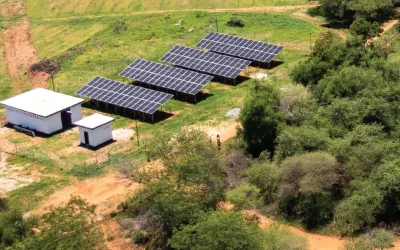Govt to drive clean energy production
GOVERNMENT is expediting initiatives to ramp up renewable power output to meet the country’s needs amid the global campaign to scale down fossil-fuelled power plants under the “no new coal agenda”.
As part of the plans, it is increasing power generation using diverse sources of energy available in the country as it seeks to accelerate the use of renewable sources that include solar, wind, hydro whilst incorporating new innovative solutions.
This is in tandem with the 2019 renewable energy policy that targets the installation of 1 100 megawatts (MW) and 2100 MW of renewable energy by 2025 and 2030 respectively.
While giving a presentation on Tuesday at the recently held Zimbabwe Economic Development Conference (ZEDCON) 2024 in Victoria Falls, Ministry of Energy and Power Development, permanent secretary, Dr Gloria Magombo, said increasing the generation capacity of renewable energies is meant to complement baseload (coal and hydro).
The renewable energy matrix includes the Muzarabani gas to generate power as a transitional fuel.
According to Dr Magombo, the gas-to-power alternatives from the ongoing exploration work in Muzarabani and Mbire districts could become a crucial element in Zimbabwe’s energy mix.
The project has raised hopes of positive outcomes, which could unlock significant gas resources for power generation.
The Government has set a target of an installed renewable energy capacity of 26,5 percent by 2030 as provided in the Renewable Energy (RE) policy of 2019 in pursuit of a low carbon footprint economy.
This is in line with the revised National Determined Contributions (NDC) target for Zimbabwe of reducing greenhouse gas emissions by 40 percent by 2030.
Zimbabwe has been mulling reducing the use of fossil fuels known for high carbon discharge and embracing renewable energy to achieve climate change mitigation goals.
Dr Magombo said the Government had also lined up short-term solar initiatives to contain the menacing power outages with some of the projects coming before year end.
“In the short term, we have a number of projects which should be coming in before year-end to increase capacity from solar, in the medium to long term, we have solar of up to about 2,000 megawatts, which has been identified, licensed and is being looked at as a potential for development.
“The work going on in Muzarabani is key because with gas to power we can ramp up to 2 000 to 3 000 megawatts within a year or two, even using emergency power units,” said Dr Magombo.
Several IPPs have shown interest in partnering power utility companies to take more households off the main grid which translates to more energy allocation towards industry and other productive sectors.
She also spoke at length on how the Government intends to significantly tap into hydropower production through construction of Batoka, Devil’s Gauge as options to hydro power production.
“In addition to the development of another Kariba unit, we want to also bring in Batoka, Devil’s Gauge as alternatives to hydro power production, the idea is to put more reservoirs along the river, use the same water before it as it goes to Cabora Bassa, towards the Indian Ocean.”
Dr Magombo also noted the relevance and importance of tapping more into the use of green energy or energy transition minerals such as lithium, nickel and cobalt which are prevalent natural endowments in Zimbabwe.
Zimbabwe, however, lacks the capacity to process and value-add these minerals into usable energy gadgets.
These energy transition minerals are essential components in many of today’s clean energy technologies, from wind turbines to electric vehicles.
“We should introduce incentives to ensure that our energy minerals are value-added, and the country should continue to pursue this value addition in terms of transition. We have started well with lithium, with the initial concentration coming in, but we need to move for more.
“What we need is financing to develop these projects into full implementation to ensure that we have movement from high carbon to low carbon, not necessarily as Zimbabwe but the rest of the world.”
Lately, Zimbabwe is weighing immediate ways to come up with alternative power sources following global calls to digress from coal-fuelled power plants under the “no new coal agenda”.
According to Climate Trade, Zimbabwe is ranked number 100 on the carbon emissions list in the world contributing 0, 03 percent of the world’s share, while 10 countries produce most of the emissions measured in millions of tonnes of carbon dioxide in 2019.
The efforts to promote renewable energy are motivated by Sustainable Development Goal 13 (SDG 13) which calls for urgent action to combat climate change and its impacts.
Zimbabwe’s average demand in winter was 2030 MW against an average supply of 1550MW.
The variance is mainly attributable to the lower-than-expected supply from Kariba due to hydrological factors and limited imports availability-herald







